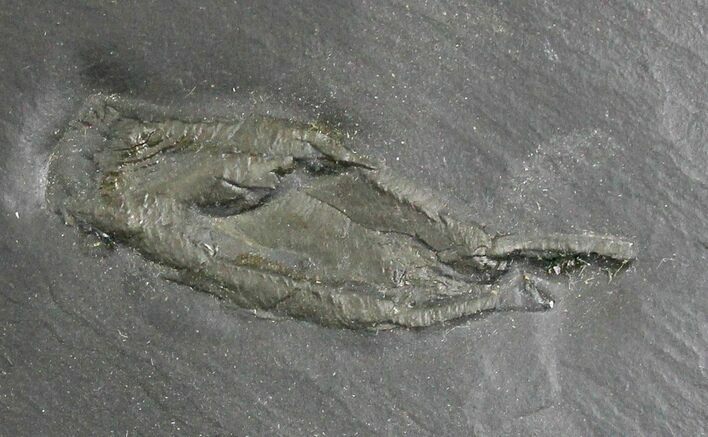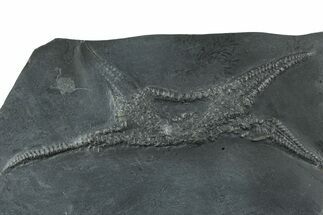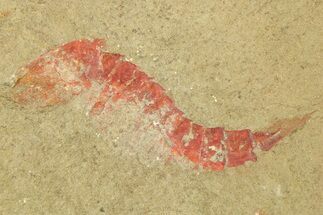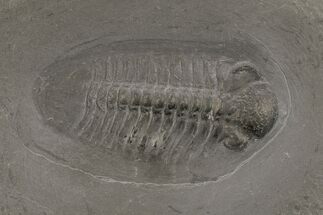This Specimen has been sold.
1.6" Devonian Phyllocarid (Nahecaris) - Bundenbach, Germany
This is an unusual Phyllocarid (Nahecaris steurtzi from the Hunsrück Slate of Germany. It's 1.6" long and rests on a 5x4.7" square piece of slate. Bundenbach quarries have been closed for some time so the only specimens coming on the market from this location is material from old collections, such as this piece.
Phyllocarids are a type of arthropod that developed during the Cambrian. They had a hard, protective shell and hinged carapace and were thought to have a life-style similar to shrimp. Exactly how they fit into arthropod the taxonomy is still under debate with it being proposed to represent a stem-lineage euarthropod or a primitive branchiopod crustacean.
The lower Devonian (lower Emsian) slates from Bundenback have been quarried for roofing material for centuries. Quarrying continued until the 1960s, when the competition from cheaper synthetic or imported slate resulted in production decline. The last pit closed in 2000. Mining of Hunsrück slate was important for the discovery of Paleozoic fossils. Although not rare, fossils can only be found through extensive mining of slate and time consuming preparation. Fossils are hard to see lying under the surface of dark slate. In 1970, Wilhelm Stürmer, a chemical physicist and radiologist developed a new method to examine the Hunsrück slate fossils using medium energy X-rays. The Bundenbach “Hunsruck Slate is famous for yeilding one of the most important assemblages of Paleozoic fossils, with 260 animal species including mollusks, echinoderms and arthropods - of which the phacopid trilobite Chotecops is certainly the most abundant.
Phyllocarids are a type of arthropod that developed during the Cambrian. They had a hard, protective shell and hinged carapace and were thought to have a life-style similar to shrimp. Exactly how they fit into arthropod the taxonomy is still under debate with it being proposed to represent a stem-lineage euarthropod or a primitive branchiopod crustacean.
The lower Devonian (lower Emsian) slates from Bundenback have been quarried for roofing material for centuries. Quarrying continued until the 1960s, when the competition from cheaper synthetic or imported slate resulted in production decline. The last pit closed in 2000. Mining of Hunsrück slate was important for the discovery of Paleozoic fossils. Although not rare, fossils can only be found through extensive mining of slate and time consuming preparation. Fossils are hard to see lying under the surface of dark slate. In 1970, Wilhelm Stürmer, a chemical physicist and radiologist developed a new method to examine the Hunsrück slate fossils using medium energy X-rays. The Bundenbach “Hunsruck Slate is famous for yeilding one of the most important assemblages of Paleozoic fossils, with 260 animal species including mollusks, echinoderms and arthropods - of which the phacopid trilobite Chotecops is certainly the most abundant.
SPECIES
Nahecaris steurtzi (Phyllocarid)
LOCATION
Bundenbach, Germany
FORMATION
Hunsrück Slate
SIZE
1.6", Matrix 5x4.7"
CATEGORY
ITEM
#28742
We guarantee the authenticity of all of our specimens.
 Reviews
Reviews











